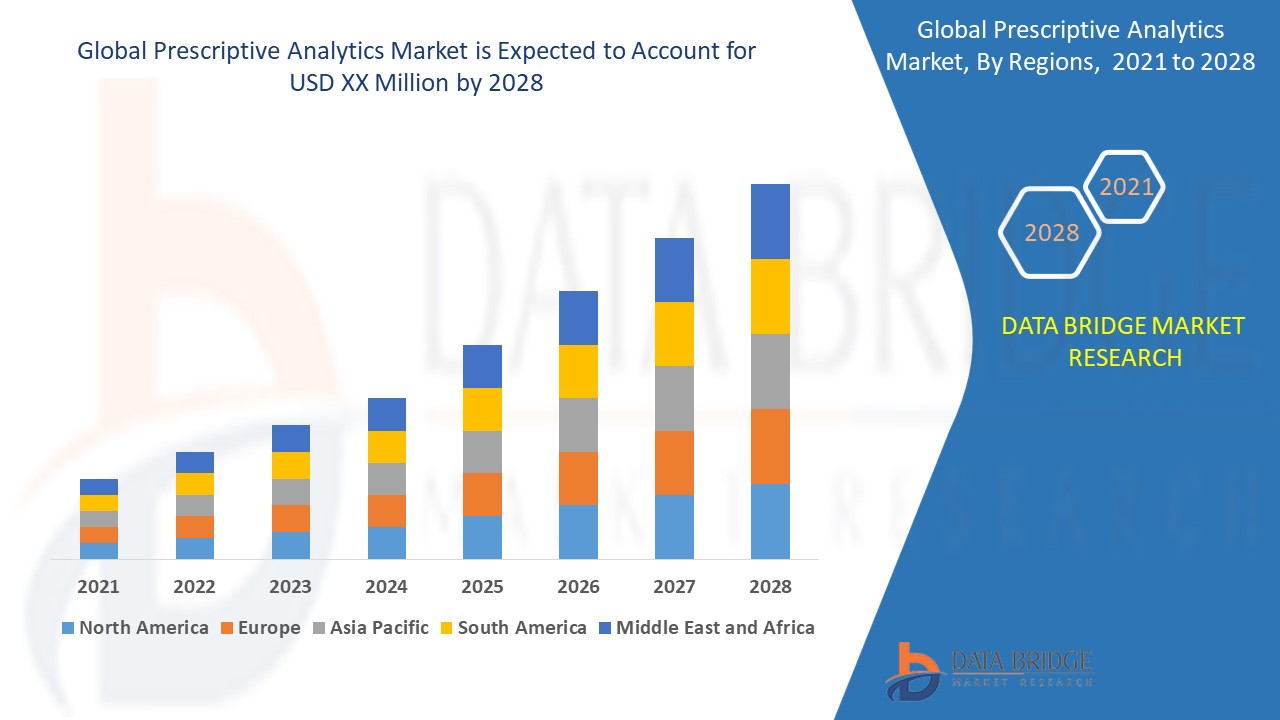Global Prescriptive Analytics Market
市场规模(十亿美元)
CAGR :
% 
 USD
5.66 Billion
USD
30.67 Billion
2023
2031
USD
5.66 Billion
USD
30.67 Billion
2023
2031
| 2024 –2031 | |
| USD 5.66 Billion | |
| USD 30.67 Billion | |
|
|
|
|
全球规范分析市场,按组件(解决方案和服务)、部署模型(现场和云)、组织规模(中小型企业和大型企业)、应用(风险管理、运营管理、收入管理、网络管理、劳动力管理、供应链管理等)、业务功能(人力资源、销售、营销、财务和运营)、数据类型(非结构化、半结构化和结构化)和最终用户(银行、金融服务和保险、电信和 IT、零售和电子商务、医疗保健和生命科学、制造业、政府和国防、能源和公用事业、运输和物流等)划分 - 行业趋势和预测到 2031 年。
规范分析市场分析和规模
在医疗保健领域,规范分析市场正在改变各个领域的决策过程。规范分析工具利用先进的算法和机器学习模型,分析患者数据、治疗结果和临床最佳实践,根据患者个人需求提供个性化的治疗建议和护理计划。医疗保健提供商利用这些工具来优化资源分配、提高运营效率并改善患者治疗效果,同时最大限度地降低成本。
2023 年全球规范分析市场规模价值为 56.6 亿美元,预计到 2031 年将达到 306.7 亿美元,2024 年至 2031 年预测期内的复合年增长率为 23.52%。
除了市场价值、增长率、细分市场、地理覆盖范围、市场参与者和市场情景等市场洞察之外,Data Bridge 市场研究团队策划的市场报告还包括深入的专家分析、进出口分析、定价分析、生产消费分析和 pestle 分析。
报告范围和市场细分
|
报告指标 |
细节 |
|
预测期 |
2024-2031 |
|
基准年 |
2023 |
|
历史岁月 |
2022 (可定制为 2016-2021) |
|
定量单位 |
收入(单位:十亿美元)、销量(单位:台)、定价(美元) |
|
涵盖的领域 |
组件(解决方案和服务)、部署模型(本地和云)、组织规模(中小型企业和大型企业)、应用(风险管理、运营管理、收入管理、网络管理、劳动力管理、供应链管理等)、业务功能(人力资源、销售、营销、财务和运营)、数据类型(非结构化、半结构化和结构化)和最终用户(银行、金融服务和保险、电信和 IT、零售和电子商务、医疗保健和生命科学、制造业、政府和国防、能源和公用事业、运输和物流等) |
|
覆盖国家 |
美国、加拿大、墨西哥、德国、法国、英国、荷兰、瑞士、比利时、俄罗斯、意大利、西班牙、土耳其、欧洲其他地区、中国、日本、印度、韩国、新加坡、马来西亚、澳大利亚、泰国、印度尼西亚、菲律宾、亚太地区 (APAC) 其他地区、沙特阿拉伯、阿联酋、南非、埃及、以色列、中东和非洲 (MEA) 其他地区、巴西、阿根廷和南美洲其他地区 |
|
涵盖的市场参与者 |
微软(美国)、甲骨文(美国)、SAP SE(德国)、SAS Institute Inc.(美国)、谷歌(美国)、Salesforce(美国)、亚马逊网络服务公司(美国)、惠普企业发展有限公司(美国)、Teradata(美国)、ALTERYX, INC.(美国)、FICO(美国)、Altair Engineering, Inc.(美国)、Domo, Inc.(美国)、Cloudera, Inc.(美国)、Board International(瑞士)、TIBCO Software Inc.(美国)、Hitachi Vantara LLC(日本)、Happiest Minds(印度)、Dataiku(法国)、QlikTech International AB(瑞典) |
|
市场机会 |
|
市场定义
规范分析是一种先进的分析方法,它通过为决策提供可操作的建议,超越了描述分析和预测分析。它利用数学算法、人工智能和机器学习来提供实现特定目标或解决业务挑战的最佳策略建议。
铁路资产管理市场动态
驱动程序
- 提高来自不同来源的数据可用性
来自物联网设备、社交媒体和企业系统等各种来源的数据为规范分析工具提供了丰富的基础,可用于分析和得出可付诸行动的见解。有了更多种类和更大量的可用数据,组织可以做出更明智的决策、优化流程并发现以前无法访问的隐藏模式或相关性。此外,数据的激增推动了分析算法和技术的创新,进一步增强了规范分析解决方案为跨行业战略决策提供宝贵建议的能力。
- 快速的技术创新
分析技术(例如机器学习算法、自然语言处理和优化技术)的不断进步提高了规范分析软件解决方案的功能和准确性。这些创新使组织能够从其数据中获得更深入的见解,做出更明智的决策,并发现以前未发现的模式或相关性。此外,随着新技术的出现和成熟,规范分析的潜在应用扩展到各个行业,为企业优化运营、降低风险和推动增长创造了新的机会。
机会
- 提高对规范分析的认识
组织越来越了解规范分析在优化决策过程方面的能力;对这些解决方案的需求日益增长。随着认识的提高,人们认识到了潜在的好处,包括提高运营效率、增强竞争力和更好地分配资源。此外,随着利益相关者见证成功的实施和展示切实成果的案例研究,对规范分析的信心不断增强,进一步推动了其采用。随着企业越来越多地优先考虑数据驱动战略来推动创新和实现战略目标,这种不断提高的认识为市场扩张创造了有利的环境。
- 监管合规性的提高
监管合规性对金融、医疗保健和制药等行业提出了严格的标准,因此需要准确且主动的风险管理措施。规范分析使组织能够分析大量数据、预测潜在的合规性问题并推荐最佳策略以确保遵守法规。因此,这一要求推动了对规范分析解决方案的需求,以便企业能够遵守不断变化的监管框架,同时保持运营效率和竞争力。
限制/挑战
- 实施流程复杂
将这些高级分析工具集成到现有 IT 基础架构中通常需要进行大量定制、数据集成和系统集成工作。组织在将规范分析解决方案与其特定业务流程和目标相结合方面面临挑战,这导致实施过程复杂化。此外,确保与各种数据源和系统的无缝互操作性进一步增加了复杂性。
- 维护成本高
除了购买规范分析工具的初始投资外,组织通常还会遇到与软件更新、硬件升级和人员培训相关的大量持续开支。这些成本可能会给预算和资源造成压力,尤其是对于小型企业或利润微薄的企业而言。维护规范分析系统的复杂性(包括排除技术故障和确保数据质量)进一步增加了财务负担。由于担心长期可持续性和投资回报,组织不愿采用或扩大规范分析的使用。
本市场报告详细介绍了最新发展、贸易法规、进出口分析、生产分析、价值链优化、市场份额、国内和本地市场参与者的影响,分析了新兴收入领域的机会、市场法规的变化、战略市场增长分析、市场规模、类别市场增长、应用领域和主导地位、产品批准、产品发布、地域扩展、市场技术创新。如需获取更多市场信息,请联系 Data Bridge Market Research 获取分析师简报,我们的团队将帮助您做出明智的市场决策,实现市场增长。
规范分析市场范围
市场根据组件、部署模型、组织规模和最终用户进行细分。细分市场之间的增长有助于您分析利基增长点和进入市场的策略,并确定您的核心应用领域和目标市场的差异。
部署模型
- 云
- 本地
成分
- 解决方案
- 财务分析
- 欺诈检测
- 盈利能力管理
- 治理
- 风险与合规管理
- 其他的
- 风险分析
- 网络风险管理
- 运营风险管理
- 信用及市场风险管理
- 其他的
- 营销分析
- 预测模型
- 收益管理
- 产品和服务发展战略
- 其他的
- 销售分析
- 销售生命周期管理
- 销售代表效率管理
- 其他的
- 客户分析
- 客户细分和聚类
- 客户行为分析
- 监控客户忠诚度和满意度
- 其他的
- 网络和社交媒体分析
- 社交媒体管理
- 搜索引擎优化
- 性能监控
- 竞争对手基准测试
- 供应链分析
- 配送与物流优化
- 库存管理
- 制造分析
- 其他的
- 网络分析
- 智能网络优化
- 交通管理
- 其他的
- 其他的
- 财务分析
- 服务
- 托管服务
- 专业服务
- 咨询
- 一体化
- 部署
组织规模
- 中小企业
- 大型企业
应用
- 风险管理
- 运营管理
- 收益管理
- 网管
- 劳动力管理
- 供应链管理
- 其他
业务功能
- 人力资源
- 销售量
- 营销
- 金融
- 运营
数据类型
- 非结构化
- 半结构化
- 结构化
最终用户
- 银行业
- 金融服务
- 保险
- 电信和 IT
- 零售和电子商务
- 医疗保健和生命科学
- 制造业
- 政府和国防
- 能源和公用事业
- 运输和物流
- 其他的
规范分析市场区域分析/洞察
对市场进行了分析,并提供了 上述国家、组件、部署模型、组织规模和最终用户的市场规模和数量信息。
市场报告涉及的国家包括美国、加拿大、墨西哥、巴西、阿根廷和南美洲其他地区、德国、意大利、英国、法国、西班牙、荷兰、比利时、瑞士、土耳其、俄罗斯、欧洲其他地区、日本、中国、印度、韩国、澳大利亚、新加坡、马来西亚、泰国、印度尼西亚、菲律宾、亚太地区其他地区 (APAC)、沙特阿拉伯、阿联酋、南非、埃及、以色列、中东和非洲其他地区 (MEA)。
由于北美企业对预测分析措施重要性的认识不断提高,北美在市场中占据主导地位。快速的技术进步,尤其是机器学习和大数据分析领域的进步,推动了预测分析解决方案的采用。此外,北美拥有大量成熟的市场参与者和创新型初创企业,为该行业的增长做出了贡献。这些因素的结合使北美成为推动预测分析解决方案进步和采用的领导者。
亚太地区市场预计将大幅增长,这主要归功于先进预测分析解决方案的日益普及和广泛接受。这些技术使企业能够获得宝贵的见解、优化运营并做出数据驱动的决策,从而提高效率和竞争力。随着技术格局的快速发展和对创新的日益重视,亚太地区各个行业的企业都在采用预测分析来保持领先地位并利用新兴机会。这一趋势预计将推动该地区经济的大幅扩张,营造一个充满活力的创新和增长环境。
全球销售自动化软件市场报告的国家部分还提供了影响单个市场因素和国内市场法规变化,这些因素和变化会影响市场的当前和未来趋势。消费量、生产地点和产量、进出口分析、价格趋势分析、原材料成本、下游和上游价值链分析等数据点是用于预测单个国家市场情景的一些主要指标。此外,在提供国家数据的预测分析时,还考虑了全球品牌的存在和可用性以及它们因来自本地和国内品牌的激烈或稀少竞争而面临的挑战、国内关税和贸易路线的影响。
竞争格局和规范分析市场份额分析
市场竞争格局按竞争对手提供详细信息。详细信息包括公司概况、公司财务状况、产生的收入、市场潜力、研发投资、新市场计划、全球影响力、生产基地和设施、生产能力、公司优势和劣势、产品发布、产品宽度和广度、应用主导地位。以上提供的数据点仅与公司对市场的关注有关。
市场上的一些主要参与者包括:
- 微软 (美国)
- 甲骨文 (美国)
- SAP SE(德国)
- SAS Institute Inc.(美国)
- 谷歌(美国)
- Salesforce(美国)
- 亚马逊网络服务公司(美国)
- 惠普企业发展有限公司 (美国)
- Teradata (美国)
- ALTERYX, INC.(美国)
- FICO(美国)
- Altair Engineering, Inc.(美国)
- Domo, Inc.(美国)
- Cloudera, Inc.(美国)
- Board International(瑞士)
- TIBCO Software Inc.(美国)
- Hitachi Vantara LLC(日本)
- 最幸福的心灵(印度)
- Dataiku(法国)
- QlikTech International AB(瑞典)
SKU-
Get online access to the report on the World's First Market Intelligence Cloud
- Interactive Data Analysis Dashboard
- Company Analysis Dashboard for high growth potential opportunities
- Research Analyst Access for customization & queries
- Competitor Analysis with Interactive dashboard
- Latest News, Updates & Trend analysis
- Harness the Power of Benchmark Analysis for Comprehensive Competitor Tracking
研究方法
数据收集和基准年分析是使用具有大样本量的数据收集模块完成的。该阶段包括通过各种来源和策略获取市场信息或相关数据。它包括提前检查和规划从过去获得的所有数据。它同样包括检查不同信息源中出现的信息不一致。使用市场统计和连贯模型分析和估计市场数据。此外,市场份额分析和关键趋势分析是市场报告中的主要成功因素。要了解更多信息,请请求分析师致电或下拉您的询问。
DBMR 研究团队使用的关键研究方法是数据三角测量,其中包括数据挖掘、数据变量对市场影响的分析和主要(行业专家)验证。数据模型包括供应商定位网格、市场时间线分析、市场概览和指南、公司定位网格、专利分析、定价分析、公司市场份额分析、测量标准、全球与区域和供应商份额分析。要了解有关研究方法的更多信息,请向我们的行业专家咨询。
可定制
Data Bridge Market Research 是高级形成性研究领域的领导者。我们为向现有和新客户提供符合其目标的数据和分析而感到自豪。报告可定制,包括目标品牌的价格趋势分析、了解其他国家的市场(索取国家列表)、临床试验结果数据、文献综述、翻新市场和产品基础分析。目标竞争对手的市场分析可以从基于技术的分析到市场组合策略进行分析。我们可以按照您所需的格式和数据样式添加您需要的任意数量的竞争对手数据。我们的分析师团队还可以为您提供原始 Excel 文件数据透视表(事实手册)中的数据,或者可以帮助您根据报告中的数据集创建演示文稿。














